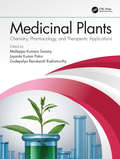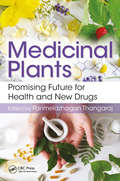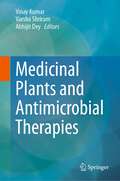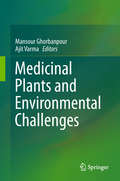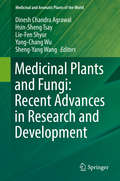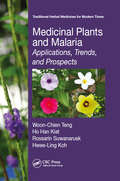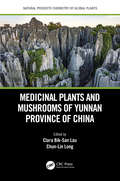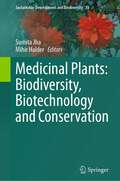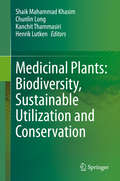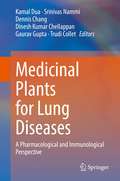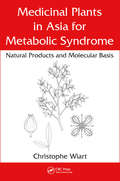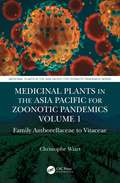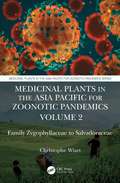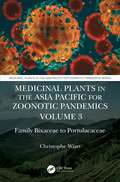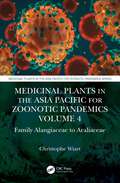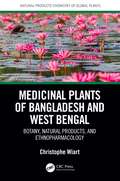- Table View
- List View
Medicinal Plants: Chemistry, Pharmacology, and Therapeutic Applications
by Mallappa Kumara Swamy Jayanta Kumar Patra Gudepalya Renukaiah RudramurthyThis book details several important medicinal plants, their occurrence, plant compounds and their chemical structures, and pharmacological properties against various human diseases. It also gives information on isolation and structural elucidation of phytocompounds, bio-assays, metabolomic studies, and therapeutical applications of plant compounds.
Medicinal Plants: Promising Future for Health and New Drugs
by Parimelazhagan ThangarajThis book highlights the importance of traditional medicines, focuses on the standardization of herbal medicine and evaluates opportunities for advancing drug research. It addresses issues in utilization of medicinal plants and shares the importance of herbs in neutraceutics. It provides most competitive techniques being used in research.
Medicinal Plants: Promising Future for Health and New Drugs
by Parimelazhagan ThangarajThis book highlights the importance of traditional medicines, focuses on the standardization of herbal medicine and evaluates opportunities for advancing drug research. It addresses issues in utilization of medicinal plants and shares the importance of herbs in neutraceutics. It provides most competitive techniques being used in research.
Medicinal Plants and Antimicrobial Therapies
by Vinay Kumar Varsha Shriram Abhijit DeyThis book serves as an excellent comprehensive material covering the current understandings and updates on antimicrobial resistance (AMR) and the use of medicinal plant resources for tackling it. Chapters cover important aspects of AMR and strategies to address this threatening issue with medicinal plants and their resources. One health perspectives for addressing AMR have been presented for the readers. Antimicrobial medicinal plant therapeutic resources including crude extracts, active fractions, pure molecules and essential oils, besides using them as functionalizing agents for nano-antimicrobials have been covered. Further, plant endophytes as a source of antimicrobial compounds have been discussed. Chapters cover both the bactericidal as well as resistance-reversal (or potentiating/ combinatorial therapies) potencies of medicinal plant resources. The book also focuses on how medicinal plant resources effectively target major determinants of AMR. Use of metabolomics in understanding and targeting AMR mechanisms and identifying potent phyto-therapeutics has been discussed as well. The book is a valuable read for both experienced and younger researchers working in the field of AMR and related fields in biomedicine, pharmacy, and clinical research.
Medicinal Plants and Environmental Challenges
by Mansour Ghorbanpour Ajit VarmaThis book sheds new light on the role of various environmental factors in regulating the metabolic adaptation of medicinal and aromatic plants. Many of the chapters present cutting-edge findings on the contamination of medicinal plants through horizontal transfer, as well as nanomaterials and the biosynthesis of pharmacologically active compounds. In addition, the book highlights the impacts of environmental factors (e.g., high and low temperature, climate change, global warming, UV irradiation, intense sunlight and shade, ozone, carbon dioxide, drought, salinity, nutrient deficiency, agrochemicals, waste, heavy metals, nanomaterials, weeds, pests and pathogen infections) on medicinal and aromatic plants, emphasizing secondary metabolisms. In recent years, interest has grown in the use of bioactive compounds from natural sources. Medicinal and aromatic plants constitute an important part of the natural environment and agro-ecosystems, and contain a wealth of chemical compounds known as secondary metabolites and including alkaloids, glycosides, essential oils and other miscellaneous active substances. These metabolites help plants cope with environmental and/or external stimuli in a rapid, reversible and ecologically meaningful manner. Additionally, environmental factors play a crucial role in regulating the metabolic yield of these biologically active molecules. Understanding how medicinal plants respond to environmental perturbations and climate change could open new frontiers in plant production and in agriculture, where successive innovation is urgently needed due to the looming challenges in connection with global food security and climate change. Readers will discover a range of revealing perspectives and the latest research on this vital topic.
Medicinal Plants and Fungi: Recent Advances in Research and Development (Medicinal and Aromatic Plants of the World #4)
by Dinesh Chandra Agrawal Hsin-Sheng Tsay Lie-Fen Shyur Yang-Chang Wu Sheng-Yang WangThis book highlights the latest international research on different aspects of medicinal plants and fungi. Studies over the last decade have demonstrated that bioactive compounds isolated from medicinal fungi have promising antitumor, cardiovascular, immunomodulatory, anti-allergic, anti-diabetic, and hepatoprotective properties. In the light of these studies, the book includes chapters (mostly review articles) by eminent researchers from twelve countries across the globe working in different disciplines of medicinal plants and fungi. It discusses topics such as the prevention of major neurodegenerative and neurotoxic mechanisms by Centella asiatica; the medicinal properties and therapeutic applications of several mushrooms species found in different parts of the world; and fungal endophytes as a source of bioactive metabolites including anticancer and cardioprotective agents. There are also chapters on strategies for identifying bioactive secondary metabolites of fungal origin; the use of genomic information to explore the biotechnological potential of medicinal mushrooms; and solid state fermentation of agro-industrial and forestry residues for the production of medicinal mushrooms. It is a valuable resource for the researchers, professionals and students working in the area of medicinal plants and fungi.
Medicinal Plants and Malaria: Applications, Trends, and Prospects (Traditional Herbal Medicines For Modern Times Ser.)
by Woon-Chien Teng Ho Han Kiat Rossarin Suwanarusk Hwee-Ling KohMalaria is a potentially life-threatening disease that affects millions worldwide, especially in Sub-Saharan Africa. The recent emergence and spread of multidrug resistance in parts of Southeast Asia prompts the urgent need for novel and effective therapy against the disease. Medicinal Plants and Malaria: Applications, Trends, and Prospects highlig
Medicinal Plants and Malaria: Applications, Trends, and Prospects (Traditional Herbal Medicines For Modern Times Ser.)
by Woon-Chien Teng Ho Han Kiat Rossarin Suwanarusk Hwee-Ling KohMalaria is a potentially life-threatening disease that affects millions worldwide, especially in Sub-Saharan Africa. The recent emergence and spread of multidrug resistance in parts of Southeast Asia prompts the urgent need for novel and effective therapy against the disease. Medicinal Plants and Malaria: Applications, Trends, and Prospects highlig
Medicinal Plants and Mushrooms of Yunnan Province of China (Natural Products Chemistry of Global Plants)
by Clara Bik-San Lau and Chun-Lin LongAlthough many texts describe plants from China, the focus of this book is to draw on the rich culture and environment of medicinal plants and fungi/mushrooms of Yunnan Province. In fact, Yunnan Province covers two global hotspots of biodiversity, with the richest biological and cultural diversity in China. In particular, the Kunming Institute of Botany (KIB) of the Chinese Academy of Sciences (founded in 1938 and located in the capital city of Yunnan Province) has made great contributions in the fields of botany and phytochemistry, earning an international reputation. This book covers those medicinal plants and fungi/mushrooms specific to Yunnan Province, and is written mainly by KIB experts in this research field. Key Features: Distinct sections cover the breadth of the topic including resource availability (wildly grown or cultivated), sustainability, and distribution Discusses plant parts used for medicinal uses (the folklore, the ancient and modern uses) Describes the important natural products and the known pharmacologically active components Presents biological activities related to medicinal uses or clinical evidence Cover image: Shilin, the stone forest (eroded vertical pinnacles of limestone), landmark of Kunming, Yunnan.
Medicinal Plants and Mushrooms of Yunnan Province of China (Natural Products Chemistry of Global Plants)
by Clara Bik-San Lau Chun-Lin LongAlthough many texts describe plants from China, the focus of this book is to draw on the rich culture and environment of medicinal plants and fungi/mushrooms of Yunnan Province. In fact, Yunnan Province covers two global hotspots of biodiversity, with the richest biological and cultural diversity in China. In particular, the Kunming Institute of Botany (KIB) of the Chinese Academy of Sciences (founded in 1938 and located in the capital city of Yunnan Province) has made great contributions in the fields of botany and phytochemistry, earning an international reputation. This book covers those medicinal plants and fungi/mushrooms specific to Yunnan Province, and is written mainly by KIB experts in this research field. Key Features: Distinct sections cover the breadth of the topic including resource availability (wildly grown or cultivated), sustainability, and distribution Discusses plant parts used for medicinal uses (the folklore, the ancient and modern uses) Describes the important natural products and the known pharmacologically active components Presents biological activities related to medicinal uses or clinical evidence Cover image: Shilin, the stone forest (eroded vertical pinnacles of limestone), landmark of Kunming, Yunnan.
Medicinal Plants: Biodiversity, Biotechnology and Conservation (Sustainable Development and Biodiversity #33)
by Sumita Jha Mihir HalderThis contributed volume provides a comprehensive, in-depth and subject-based reviews on the current status of active ingredients, sustainable use, biodiversity and conservation of certain endangered medicinal plants. The book also explores conventional and non-conventional biotechnological interventions for their biodiversity conservation. Medicinal plants have been used in worldwide as a major source of raw material for the traditional herbal healthcare practices as well as for drug discovery and development in pharmaceutical industry. The cumulative consequences of various human activities and environmental factors cause decline in the biodiversity of medicinal plants at an unprecedented rate worldwide. Thus, the overall understanding of ecology, species and genetic diversity along with assessment of the status of different threats and their impact on medicinal plants is crucial to sustain existing biodiversity, its utilization and conservation. All the latest advancements in the biotechnological approaches for the conservation research of endangered medicinal plants and the future perspectives have been described. This book provides comprehensive reviews spreading over about 25 chapters divided in three sections. The chapters of this book are written by recognized scientists in their respective fields which are useful to students, academicians, researchers, botanists, biotechnologists, policy makers, conservationists and industries interested in biodiversity conservation and medicinal plant research for the production of secondary metabolites.
Medicinal Plants: Biodiversity, Sustainable Utilization and Conservation
by Shaik Mahammad Khasim Kanchit Thammasiri Chunlin Long Henrik LutkenPlants have been a source of medicines and have played crucial role for human health. Despite tremendous advances in the field of synthetic drugs and antibiotics, plants continue to play a vital role in modern as well as traditional medicine across the globe. In even today, one-third of the world’s population depends on traditional medicine because of its safety features and ability to effectively cure diseases. This book presents a comprehensive guide to medicinal plants, their utility, diversity and conversation, as well as biotechnology. It is divided into four main sections, covering all aspects of research in medicinal plants: biodiversity and conservation; ethnobotany and ethnomedicine; bioactive compounds from plants and microbes; and biotechnology. All sections cover the latest advances. The book offers a valuable asset for researchers and graduate students of biotechnology, botany, microbiology and the pharmaceutical sciences. It is an equally important resource for doctors (especially those engaged in Ayurveda and allopathy); the pharmaceutical industry (for drug design and synthesis); and the agricultural sciences.
Medicinal Plants for Lung Diseases: A Pharmacological and Immunological Perspective
by Gaurav Gupta Kamal Dua Srinivas Nammi Dennis Chang Dinesh Kumar Chellappan Trudi ColletThis book summarizes experimentally-supported research on the therapeutic efficacy of plant extracts and their constituents on a range of respiratory diseases including infections. It discusses the pharmacological, cellular and molecular factors involved in the pathogenies of respiratory diseases and their modulation by plant-derived compounds. Additionally, it underlines the growing relevance of medicinal plant-based advanced drug delivery systems for treating lung diseases providing maximal therapeutic efficacy with better patient compliance. Overall, this comprehensive book is a blend of translational, biological, chemical and drug delivery aspects of medicinal plants employed in targeting respiratory diseases and attracts a range of audiences including physiochemist, translational and clinical researchers working in the field of respiratory diseases.
Medicinal Plants in Asia for Metabolic Syndrome: Natural Products and Molecular Basis
by Christophe WiartMedicinal Plants in Asia for Metabolic Syndrome: Natural Products and Molecular Basis offers an in-depth view into the metabolic syndrome pharmacology of natural products with an emphasis on their molecular basis, cellular pathways, metabolic organs, and endocrine regulations. This sensational volume provides the scientific names, botanical classifications, botanical descriptions, medicinal uses, chemical constituents, and pharmacological activities of more than 100 Asian plants, with high quality original botanical plates, chemical structures, and pharmacological diagrams. It also lists hundreds of carefully selected bibliographical references, constituents on insulin resistance, obesity, atherosclerosis, atherogenic dyslipidemia, and endothelial dysfunction.
Medicinal Plants in Asia for Metabolic Syndrome: Natural Products and Molecular Basis
by Christophe WiartMedicinal Plants in Asia for Metabolic Syndrome: Natural Products and Molecular Basis offers an in-depth view into the metabolic syndrome pharmacology of natural products with an emphasis on their molecular basis, cellular pathways, metabolic organs, and endocrine regulations. This sensational volume provides the scientific names, botanical classifications, botanical descriptions, medicinal uses, chemical constituents, and pharmacological activities of more than 100 Asian plants, with high quality original botanical plates, chemical structures, and pharmacological diagrams. It also lists hundreds of carefully selected bibliographical references, constituents on insulin resistance, obesity, atherosclerosis, atherogenic dyslipidemia, and endothelial dysfunction.
Medicinal Plants in the Asia Pacific for Zoonotic Pandemics, Volume 1: Family Amborellaceae to Vitaceae (Medicinal Plants in the Asia Pacific for Zoonotic Pandemics #1)
by Christophe WiartMedicinal Plants in the Asia Pacific for Zoonotic Pandemics provides an unprecedented, comprehensive overview of the phylogeny, botany, ethnopharmacology, and pharmacology of more than 100 plants used in the traditional medical systems of Asia and Pacific. It discusses their actions and potentials against viruses, bacteria, and fungi that represent a threat of epidemic and pandemic diseases, with an emphasis on the molecular basis and cellular pathways. This book presents scientific names, the botanical classification, traditional medicinal uses, active chemical constituents, and pharmacology. This volume is a critical reference for anyone involved in the discovery of lead molecules or phytopharmaceutical products for the prevention or treatment of pandemic viral, bacterial, or fungal infections. FEATURES Phylogenetic presentation of medicinal plants and a chemotaxonomical rationale of antiviral, antibacterial, and antifungal actions Discusses the chemical structure–activity relationship, pharmacokinetics, and oral bioavailability of antimicrobial principles Introduces the molecular mechanism of natural products on viruses, bacteria, and fungi Contains a selection of botanical plates and useful bibliographic references This book is a useful research tool for postgraduates, academics, and the pharmaceutical, herbal, and nutrition industries. Medicinal Plants in the Asia Pacific for Zoonotic Pandemics includes commentary sections that invite further research and reflection on the fascinating and timely subject of the development of drugs and herbals from Asia-Pacific medicinal plants to safeguard humanity and other life forms against the forthcoming waves of viral, bacterial, or fungal pandemics. This book is an ideal reference text for medicinal plant enthusiasts.
Medicinal Plants in the Asia Pacific for Zoonotic Pandemics, Volume 1: Family Amborellaceae to Vitaceae (Medicinal Plants in the Asia Pacific for Zoonotic Pandemics #1)
by Christophe WiartMedicinal Plants in the Asia Pacific for Zoonotic Pandemics provides an unprecedented, comprehensive overview of the phylogeny, botany, ethnopharmacology, and pharmacology of more than 100 plants used in the traditional medical systems of Asia and Pacific. It discusses their actions and potentials against viruses, bacteria, and fungi that represent a threat of epidemic and pandemic diseases, with an emphasis on the molecular basis and cellular pathways. This book presents scientific names, the botanical classification, traditional medicinal uses, active chemical constituents, and pharmacology. This volume is a critical reference for anyone involved in the discovery of lead molecules or phytopharmaceutical products for the prevention or treatment of pandemic viral, bacterial, or fungal infections. FEATURES Phylogenetic presentation of medicinal plants and a chemotaxonomical rationale of antiviral, antibacterial, and antifungal actions Discusses the chemical structure–activity relationship, pharmacokinetics, and oral bioavailability of antimicrobial principles Introduces the molecular mechanism of natural products on viruses, bacteria, and fungi Contains a selection of botanical plates and useful bibliographic references This book is a useful research tool for postgraduates, academics, and the pharmaceutical, herbal, and nutrition industries. Medicinal Plants in the Asia Pacific for Zoonotic Pandemics includes commentary sections that invite further research and reflection on the fascinating and timely subject of the development of drugs and herbals from Asia-Pacific medicinal plants to safeguard humanity and other life forms against the forthcoming waves of viral, bacterial, or fungal pandemics. This book is an ideal reference text for medicinal plant enthusiasts.
Medicinal Plants in the Asia Pacific for Zoonotic Pandemics, Volume 2: Family Zygophyllaceae to Salvadoraceae (Medicinal Plants in the Asia Pacific for Zoonotic Pandemics)
by Christophe WiartMedicinal Plants in the Asia Pacific for Zoonotic Pandemics provides an unprecedented, comprehensive overview of the botany, ethnopharmacology, and pharmacology of more than 100 plants used in the traditional medical systems of Asia and Pacific medicine for the treatment of microbial infections. It discusses their actions and potentials against viruses, bacteria, and fungi that represent a threat of epidemic and pandemic diseases, with an emphasis on the molecular basis and cellular pathways. This book presents for each plant the botanical classification, synonyms, scientific names, local names, habitat, distribution, botanical description, traditional medicinal uses, antimicrobial activities, active antimicrobial principles, and commentaries. This volume is a critical reference for anyone involved in the development of lead molecules or phytopharmaceutical products for the prevention or treatment of pandemic viral, bacterial, or fungal infections. FEATURES Includes phylogenetic presentations of medicinal plants and a chemotaxonomical rationale of antiviral, antibacterial, and antifungal actions Discusses the chemical structure–activity relationship, pharmacokinetics, and oral bioavailability of antimicrobial principles Introduces the molecular mechanism of natural products on viruses, bacteria, and fungi Contains a selection of handmade botanical plates and useful bibliographic references This book is a useful research tool for postgraduates, academics, and the pharmaceutical, herbal, and nutrition industries. Medicinal Plants in the Asia Pacific for Zoonotic Pandemics includes commentary sections that invite further research and reflection on the fascinating and timely subject of the development of leads or herbals from Asia-Pacific medicinal plants to safeguard humanity against COVID-19 and the forthcoming waves of viral, bacterial, or fungal pandemics. This book is an ideal reference text for medicinal plant enthusiasts.
Medicinal Plants in the Asia Pacific for Zoonotic Pandemics, Volume 2: Family Zygophyllaceae to Salvadoraceae (Medicinal Plants in the Asia Pacific for Zoonotic Pandemics)
by Christophe WiartMedicinal Plants in the Asia Pacific for Zoonotic Pandemics provides an unprecedented, comprehensive overview of the botany, ethnopharmacology, and pharmacology of more than 100 plants used in the traditional medical systems of Asia and Pacific medicine for the treatment of microbial infections. It discusses their actions and potentials against viruses, bacteria, and fungi that represent a threat of epidemic and pandemic diseases, with an emphasis on the molecular basis and cellular pathways. This book presents for each plant the botanical classification, synonyms, scientific names, local names, habitat, distribution, botanical description, traditional medicinal uses, antimicrobial activities, active antimicrobial principles, and commentaries. This volume is a critical reference for anyone involved in the development of lead molecules or phytopharmaceutical products for the prevention or treatment of pandemic viral, bacterial, or fungal infections. FEATURES Includes phylogenetic presentations of medicinal plants and a chemotaxonomical rationale of antiviral, antibacterial, and antifungal actions Discusses the chemical structure–activity relationship, pharmacokinetics, and oral bioavailability of antimicrobial principles Introduces the molecular mechanism of natural products on viruses, bacteria, and fungi Contains a selection of handmade botanical plates and useful bibliographic references This book is a useful research tool for postgraduates, academics, and the pharmaceutical, herbal, and nutrition industries. Medicinal Plants in the Asia Pacific for Zoonotic Pandemics includes commentary sections that invite further research and reflection on the fascinating and timely subject of the development of leads or herbals from Asia-Pacific medicinal plants to safeguard humanity against COVID-19 and the forthcoming waves of viral, bacterial, or fungal pandemics. This book is an ideal reference text for medicinal plant enthusiasts.
Medicinal Plants in the Asia Pacific for Zoonotic Pandemics, Volume 3: Family Bixaceae to Portulacaceae (Medicinal Plants in the Asia Pacific for Zoonotic Pandemics)
by Christophe WiartMedicinal Plants in the Asia Pacific for Zoonotic Pandemics provides an unprecedented, comprehensive overview of the phylogeny, botany, ethnopharmacology, and pharmacology of more than 100 plants used in the traditional systems of Asia and Pacific medicine for the treatment of microbial infections. It discusses their actions and potentials against viruses, bacteria, and fungi that represent a threat of epidemic and pandemic diseases, with an emphasis on the molecular basis and cellular pathways. This book presents for each plant the scientific name, the botanical classification, traditional medicinal uses, active chemical constituents, and pharmacology. This volume is a critical reference for anyone involved in the discovery of leads for the development of lead molecules or phytopharmaceutical products for the prevention or treatment of pandemic viral, bacterial, or fungal infections. FEATURES Includes phylogenetic presentation of medicinal plants and a chemotaxonomical rationale of antiviral, antibacterial, and antifungal actions Discusses chemical structure–activity relationship, pharmacokinetics, and oral bioavailability of antimicrobial principles Introduces the molecular mechanism of natural products on viruses, bacteria, and fungi Contains a selection of botanical plates and useful bibliographic references This book is a useful research tool for postgraduates, academics, and the pharmaceutical, herbal, and nutrition industries. Medicinal Plants in the Asia Pacific for Zoonotic Pandemics includes commentary sections that invite further research and reflection on the fascinating and timely subject of the development of leads or herbals from Asia-Pacific medicinal plants to safeguard humanity against the forthcoming waves of viral, bacterial, or fungal pandemics. This book is an ideal reference text for medicinal plant enthusiasts.
Medicinal Plants in the Asia Pacific for Zoonotic Pandemics, Volume 3: Family Bixaceae to Portulacaceae (Medicinal Plants in the Asia Pacific for Zoonotic Pandemics)
by Christophe WiartMedicinal Plants in the Asia Pacific for Zoonotic Pandemics provides an unprecedented, comprehensive overview of the phylogeny, botany, ethnopharmacology, and pharmacology of more than 100 plants used in the traditional systems of Asia and Pacific medicine for the treatment of microbial infections. It discusses their actions and potentials against viruses, bacteria, and fungi that represent a threat of epidemic and pandemic diseases, with an emphasis on the molecular basis and cellular pathways. This book presents for each plant the scientific name, the botanical classification, traditional medicinal uses, active chemical constituents, and pharmacology. This volume is a critical reference for anyone involved in the discovery of leads for the development of lead molecules or phytopharmaceutical products for the prevention or treatment of pandemic viral, bacterial, or fungal infections. FEATURES Includes phylogenetic presentation of medicinal plants and a chemotaxonomical rationale of antiviral, antibacterial, and antifungal actions Discusses chemical structure–activity relationship, pharmacokinetics, and oral bioavailability of antimicrobial principles Introduces the molecular mechanism of natural products on viruses, bacteria, and fungi Contains a selection of botanical plates and useful bibliographic references This book is a useful research tool for postgraduates, academics, and the pharmaceutical, herbal, and nutrition industries. Medicinal Plants in the Asia Pacific for Zoonotic Pandemics includes commentary sections that invite further research and reflection on the fascinating and timely subject of the development of leads or herbals from Asia-Pacific medicinal plants to safeguard humanity against the forthcoming waves of viral, bacterial, or fungal pandemics. This book is an ideal reference text for medicinal plant enthusiasts.
Medicinal Plants in the Asia Pacific for Zoonotic Pandemics, Volume 4: Family Cornaceae to Apiaceae (Medicinal Plants in the Asia Pacific for Zoonotic Pandemics #4)
by Christophe WiartViruses and plagues have constantly threatened the survival of humanity since the evolution of modern man. Medical advances, thanks to the application of remedial plants, have helped to fight back against some of the most nefarious bacterial and viral infections, giving humanity a fighting chance. This fourth volume in the Medicinal Plants in the Asia Pacific for Zoonotic Pandemics series provides an unprecedented, comprehensive overview of the pharmacological activity of more than 100 medicinal plants used for the treatment of microbial infections in Asia and the Pacific. The text discusses the actions of such plants against viruses and bacteria representing a threat of epidemic and pandemic diseases, including COVID-19, with an emphasis on the molecular basis and cellular pathways. Scientific names, botanical classifications and descriptions, medicinal uses, and chemical constituents are presented, along with chemical structures and a vast selection of bibliographical references. FEATURES Introduces the molecular mechanism of natural products from medicinal plants in Asia on bacteria and viruses Includes phylogenetic presentations of a selection of medicinal plants and a chemotaxonomical rationale of antiviral and antibacterial actions Discusses the chemical structure–activity relationship, pharmacokinetics, and bioavailability of antimicrobial principles This book is a useful research tool for postgraduates, academics, and the pharmaceutical, herbal, and nutrition industries looking forward to developing antiviral and antibacterial agents from medicinal plants in Asia. Medicinal Plants in the Asia Pacific for Zoonotic Pandemics is a critical reference for anyone involved in the discovery of leads for the treatment of pandemic viral, bacterial, and infections. "This book will be an important resource for scientists, as well as people passionate about helping to save these critical resources. Perhaps a new drug lead will be identified from at least one of these plants." —From the Foreword by Dr. Mark S. Butler, MSBChem Consulting, Brisbane, Australia
Medicinal Plants in the Asia Pacific for Zoonotic Pandemics, Volume 4: Family Cornaceae to Apiaceae (Medicinal Plants in the Asia Pacific for Zoonotic Pandemics #4)
by Christophe WiartViruses and plagues have constantly threatened the survival of humanity since the evolution of modern man. Medical advances, thanks to the application of remedial plants, have helped to fight back against some of the most nefarious bacterial and viral infections, giving humanity a fighting chance. This fourth volume in the Medicinal Plants in the Asia Pacific for Zoonotic Pandemics series provides an unprecedented, comprehensive overview of the pharmacological activity of more than 100 medicinal plants used for the treatment of microbial infections in Asia and the Pacific. The text discusses the actions of such plants against viruses and bacteria representing a threat of epidemic and pandemic diseases, including COVID-19, with an emphasis on the molecular basis and cellular pathways. Scientific names, botanical classifications and descriptions, medicinal uses, and chemical constituents are presented, along with chemical structures and a vast selection of bibliographical references. FEATURES Introduces the molecular mechanism of natural products from medicinal plants in Asia on bacteria and viruses Includes phylogenetic presentations of a selection of medicinal plants and a chemotaxonomical rationale of antiviral and antibacterial actions Discusses the chemical structure–activity relationship, pharmacokinetics, and bioavailability of antimicrobial principles This book is a useful research tool for postgraduates, academics, and the pharmaceutical, herbal, and nutrition industries looking forward to developing antiviral and antibacterial agents from medicinal plants in Asia. Medicinal Plants in the Asia Pacific for Zoonotic Pandemics is a critical reference for anyone involved in the discovery of leads for the treatment of pandemic viral, bacterial, and infections. "This book will be an important resource for scientists, as well as people passionate about helping to save these critical resources. Perhaps a new drug lead will be identified from at least one of these plants." —From the Foreword by Dr. Mark S. Butler, MSBChem Consulting, Brisbane, Australia
Medicinal Plants of Bangladesh and West Bengal: Botany, Natural Products, & Ethnopharmacology (Natural Products Chemistry of Global Plants)
by Christophe WiartMedicinal Plants of Bangladesh and West Bengal is a complete compendium. It provides the scientific name, classification, local name(s), historical background, local medicinal uses, botanical description, chemical constituents, pharmacological activity and toxicology of more than 100 medicinal spices used in Bengal. Chemical structures of active constituents are provided as well as numerous references. This book is an indispensable tool for researchers, as well as graduates in various disciplines, including pharmacy, pharmacology, medicine, biotechnology, nutrition, cosmetology and drug development. It is also suitable for anyone who is looking for natural products as leads to be developed in therapeutics, functional nutrition or cosmetology. Focuses on a group of herbs with economic importance – the spices. These herbs demonstrate the richness of chemical diversity and potential pharmacological applications Features field photos with local healers, markets and mode of preparation as well as providing a complete monograph for each plant Discusses the collection and observation of each medicinal spice and presents the ethnopharmacology recorded by the author in Bengal Provides a wealth of scientific information on medicinal spices from an expert in the field Fills an important niche due to the increasing global interests in natural foods and botanical drugs
Medicinal Plants of Bangladesh and West Bengal: Botany, Natural Products, & Ethnopharmacology (Natural Products Chemistry of Global Plants)
by Christophe WiartMedicinal Plants of Bangladesh and West Bengal is a complete compendium. It provides the scientific name, classification, local name(s), historical background, local medicinal uses, botanical description, chemical constituents, pharmacological activity and toxicology of more than 100 medicinal spices used in Bengal. Chemical structures of active constituents are provided as well as numerous references. This book is an indispensable tool for researchers, as well as graduates in various disciplines, including pharmacy, pharmacology, medicine, biotechnology, nutrition, cosmetology and drug development. It is also suitable for anyone who is looking for natural products as leads to be developed in therapeutics, functional nutrition or cosmetology. Focuses on a group of herbs with economic importance – the spices. These herbs demonstrate the richness of chemical diversity and potential pharmacological applications Features field photos with local healers, markets and mode of preparation as well as providing a complete monograph for each plant Discusses the collection and observation of each medicinal spice and presents the ethnopharmacology recorded by the author in Bengal Provides a wealth of scientific information on medicinal spices from an expert in the field Fills an important niche due to the increasing global interests in natural foods and botanical drugs
